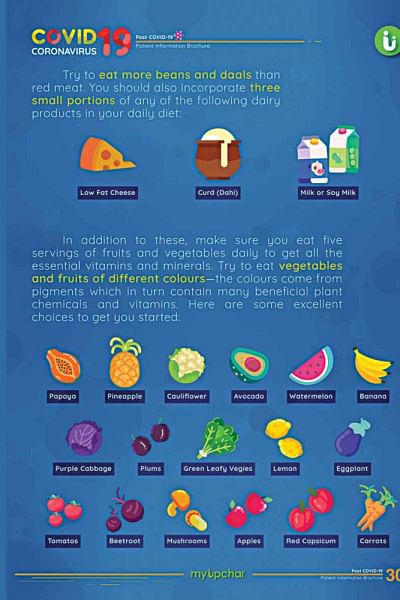Post-COVID nutrition

When our body is fighting an infection, it needs more energy and fluids, more building blocks (from protein foods) to support the immune system and help repair our body tissues during recovery. Vitamins and minerals help these processes along.
This is true for COVID-19 infection, particularly because studies have shown that even mild symptoms of it can cause damage to the heart, lungs, and the brain. We may notice some weight loss or our muscles getting smaller and weaker. Respiratory difficulties add an extra layer of complexity, preventing patients from eating effectively.
A number of patients require assisted ventilation, making it difficult to provide food and oral supplements. People might not be able to eat enough food to meet their nutritional needs during recovery, contributing to further loss of lean muscle — which could occur in ICU at the rate of up to 1 kg per day.
Nutritional recommendations will depend on physical activity and disease-related symptoms, and upon other comorbidities. For these patient groups (with comorbid condition/with other diseases), nutrition is extremely complex. It is difficult to keep these patients in a stable condition, and what makes the difference in this balance is appropriate and timely nutrition support.
Muscle wasting is the most common complication of critical illness, occurring in up to 50 percent of patients, which can seriously lengthen recovery times, impaired immunity, increase infection risk and cause the development of wounds and pressure ulcers. Even those who did not need any hospital support, mostly got effected by severe weakness even after being COVID negative due to high catabolic condition at the tenure of virus attack. This infection is likely to reduce our appetite, and affect our ability to taste and swallow. So, to follow some dietary rules are very important.
Get enough protein
Energy and protein rich nutrition according to the condition must be supplied.
Protein requirements: 1.2 to 2.0 g/kg of actual bodyweight. A protein-rich diet can help repair damaged body tissues, make up for the muscle loss, boost the immune system and overcome post-disease weakness. Protein-rich foods, like pulses, legumes, peanuts, milk, yoghurt, cheese, custard, rice pudding, sola, soy, eggs, fish, chicken, beef, and organ meat could be part of the meal.
Nutritious food preference
Having COVID-19, or any other infection means that our immune system has taken quite the beating. Replenishing the vitamins, minerals, polyphenolic compounds, phytochemicals and antioxidants our body needs is therefore an integral part of your recovery diet.
Include plenty of fresh and seasonal fruits and veggies, as well as nuts and seeds in our diet. Also, get 15-20 minutes of sunlight every day for vitamin D (1000 to 2000 IU per day for adults).
Vitamins and minerals requirement are determined by 100 percent RDA, unless there are indicated deficiencies or increased requirements. For COPD (chronic obstructive pulmonary disorder) patient calcium requirement is 1000-1200 mg/day. Frequent consumption of corticosteroids as well as immobility contribute to osteoporosis risk. Getting enough vitamin and minerals we need to eat with the rainbow; different colours provide different vitamins and minerals
Calorie-dense food
More calories mean more energy to fight off the infection and the ability to recover faster. So, include calorie-dense foods in diet but make sure they're healthy carbs. Option for whole grains, potatoes, bread, pasta, rice, milk, dates, jaggery, and chickpea. Supplement drinks can be useful if there is less intake of food due to poor appetite, breathing difficulties, or fatigue. Add dried fruits and food to improve the calorie intake.
Stay hydrated
Set yourself a target to drink minimum of 2 to 2.5 litres of fluid per day. But avoid fluid intake at the time of main meal to prevent vomiting. Potentially use a short straw when drinking if there are vomiting tendencies.
Our body would have lost a lot of fluids due to the infection and fever, so you should get plenty of them to speed up your recovery. Try drinking at the end of the meal — drinking before or during a meal may cause us to feel too full.
Some tips
Try eating little and often, for example, choose smaller meals plus snacks rather than three larger meals. Eat slowly, take smaller bites, and breathe deeply while chewing. Eat while sitting up and choose foods that are easier to chew or softer to make it easier to breathe. The soft foods and liquid can be less taxing for those that suffer from fatigue.
Appropriate spreading of nutrition across the day/increase the frequency of meals. It is preferred that every meal contains 25g protein. Routinely, approximately 6-8 times per day, consume smaller-sized portions to prevent an empty stomach.
For a dry mouth, try sucking on fruit sweets, mints or chewing gum as these can stimulate saliva production. Introduce the largest meal of the day at the best moment of the day for the patient and ensure proper rest prior to meal. Gradually increase your activity levels back to what is normal for you.
Such a recovery diet would not only help you get your strength back but also boost your immune system and keep other infections at bay until you are fully back on your feet.
Photo: Collected

 For all latest news, follow The Daily Star's Google News channel.
For all latest news, follow The Daily Star's Google News channel. 



Comments